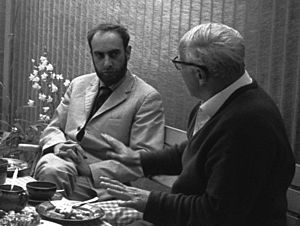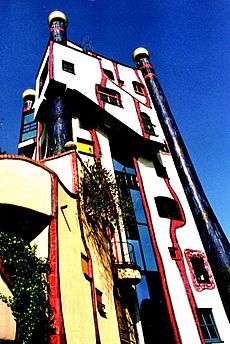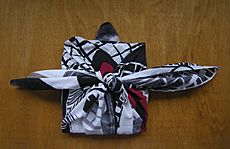Friedensreich Hundertwasser facts for kids
Quick facts for kids
Friedensreich Hundertwasser
|
|
|---|---|
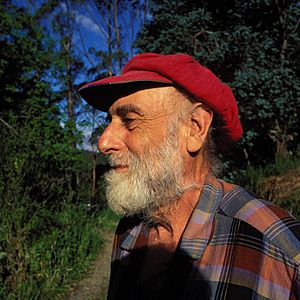
Hundertwasser in his second homeland New Zealand in 1998
|
|
| Born |
Friedrich Stowasser
15 December 1928 Vienna, Austria
|
| Died | 19 February 2000 (aged 71) aboard the Queen Elizabeth 2
|
| Nationality |
|
| Known for |
|
|
Notable work
|
|
| Movement | Modern art |
Friedrich Stowasser (15 December 1928 – 19 February 2000), known as Friedensreich Hundertwasser, was an amazing Austrian artist and architect. He was also very passionate about protecting our environment.
Hundertwasser believed that straight lines were boring and unnatural. He showed this idea in his art and especially in his building designs. His most famous work is the Hundertwasserhaus in Vienna. This building is now a popular spot in Austria's capital because it's so colourful, imaginative, and unique.
Contents
Discovering Hundertwasser's Life
Hundertwasser and his mother, who were Jewish, faced a very difficult time during the Nazi era. They stayed safe by pretending to be Christians, as his father had been Catholic. Hundertwasser was even baptized as a Catholic and joined the Hitler Youth to avoid drawing attention.
Hundertwasser showed his artistic talent from a young age. After the war, he studied art for three months at the Academy of Fine Arts Vienna. Around this time, he started signing his artwork as Hundertwasser instead of Stowasser. He then began to travel, always carrying a small set of paints to sketch whatever caught his eye.
His chosen last name, Hundertwasser, comes from "sto," a Slavic word meaning "one hundred." So, Hundertwasser means "hundred water." The name Friedensreich means "Peace-realm" or "Peace-rich." He also chose other names for himself: Regentag (Rainy day) and Dunkelbunt (Darkly multi-coloured).
In the early 1950s, he started working in architecture. Hundertwasser also designed flags, stamps, coins, and posters. His most famous flag is his Koru flag, designed in 1983. He also created several postage stamps for Austria and other countries like Cape Verde and the United Nations.
Hundertwasser got married twice, first to Herta Leitner in 1958, and later to Japanese artist Yuko Ikewada in 1962. Both marriages ended in divorce. By the 1960s, he was becoming quite famous for his art.
In 1964, Hundertwasser bought an old saw mill in a quiet, natural area of Austria. He made this his new home, away from busy city life. He also spent some time in the 1960s in Uganda, Africa, where he painted many artworks.
In the 1970s, Hundertwasser bought several properties in New Zealand. Here, he lived and worked very closely with nature. He even designed a "Bottle House" there. He tried to live without relying on outside power, using solar panels and a water wheel. He also experimented with grass roofs on his buildings.
In 1979, Hundertwasser bought a large historical garden in Venice, Italy, called Giardino Eden.
In 1982, his only child, his daughter Heidi Trimmel, was born.
Hundertwasser passed away on 19 February 2000, while on a ship in the Pacific Ocean. He was buried in New Zealand, on his land, under a Tulip Tree, just as he wished. He wanted to be buried in harmony with nature.
Hundertwasser's Artistic Style

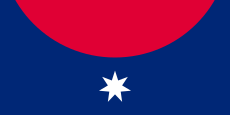
Hundertwasser's unique artistic ideas showed up in his paintings, his love for the environment, his philosophy, and his designs for buildings, stamps, flags, and clothes. His work often featured bright colours, natural shapes, and a strong belief in people being unique. He especially disliked straight lines.
His architectural work is sometimes compared to that of Antoni Gaudí, another artist who used natural, curvy shapes and tiles. Hundertwasser was also inspired by Austrian painters like Egon Schiele and Gustav Klimt.
He loved spirals and believed straight lines were "godless and immoral." He called his art theory "transautomatism," which focused on how the viewer experienced the art. This idea was seen in his design for a new flag for New Zealand. It included the Koru, a spiral shape from Māori culture that represents new life, growth, strength, and peace.
Hundertwasser's Architecture
Even though Hundertwasser first became known for his bold paintings, he is more famous for his unique building designs. These buildings use irregular shapes and include natural elements. The Hundertwasserhaus apartment building in Vienna has wavy floors, a roof covered with earth and grass, and large trees growing from inside the rooms. He didn't charge for designing the Hundertwasserhaus, saying it was worth it to "prevent something ugly from going up in its place."
From the early 1950s, he focused more on architecture. He believed buildings should be more friendly to humans and the environment. He gave speeches and wrote manifestos, like his "Mouldiness Manifesto against Rationalism in Architecture" in 1958. He rejected straight lines and plain, functional buildings.
In his manifestos, he introduced the "Window Right." This meant that a person living in an apartment should be able to lean out their window and decorate the outside wall within reach. This way, people could show their individuality and that they were different from others. He also said that planting trees in cities should be a duty. He believed that if humans live in nature, they should act like good guests.
Hundertwasser thought that boring, straight-lined buildings made people unhappy. He wanted people to have the freedom to create unique and individual structures. He also strongly supported protecting nature. He spoke out against nuclear power, to save oceans and whales, and to protect rainforests. He even promoted composting toilets, seeing human waste as part of nature's cycle.
In the 1970s, Hundertwasser started building models of his architectural ideas. These models showed his ideas for roofs covered in forests, trees growing from buildings, and the "window right." He developed new building shapes like the spiral house and the high-rise meadow house.
In the early 1980s, Hundertwasser redesigned a factory in Germany and a grain silo in Austria. He called himself an "architecture doctor" for these projects.
In his later building projects, he included his ideas of window right, tree tenants, uneven floors, and spontaneous plants on roofs. Some of his famous works include: housing complexes in Germany, a church in Austria, a heating plant in Vienna, an incineration plant in Japan, a railway station in Germany, and the Hundertwasser toilet in Kawakawa, New Zealand.
His last project, started in 1999, was called Die Grüne Zitadelle von Magdeburg (The Green Citadel of Magdeburg). Even though he passed away before it was finished, the building was completed a few years later in Germany.
- Famous Buildings
- Hundertwasserhaus, Vienna, Austria
- District Heating Plant, Spittelau, Vienna, Austria
- Hundertwasserhaus Waldspirale, Darmstadt, Germany
- KunstHausWien, Vienna, Austria
- Kindergarten Heddernheim, Frankfurt
- Motorway Restaurant, Bad Fischau-Brunn, Austria
- Hot Springs Village, Bad Blumau, Austria
- Hundertwasserkirche, Bärnbach, Austria
- Markthalle, Altenrhein, Switzerland
- Wohnen unterm Regenturm, Plochingen, Germany
- Quixote Winery, Napa Valley, United States (his only building in the US)
- Maishima Incineration Plant, Osaka, Japan
- Hundertwasser toilet, Kawakawa, New Zealand
- Hundertwasser "environmental railway station", Uelzen, Germany
- Die Grüne Zitadelle von Magdeburg, Magdeburg, Germany
- Ronald McDonald Kinder Vallei, Valkenburg aan de Geul, Netherlands
- Kuchlbauer-Turm, Abensberg, Germany
An art gallery featuring Hundertwasser's work will open in Whangārei, New Zealand. It will be based on his plans from 1993 for improving the building.
Hundertwasser's Paintings
- 1954 – Hundertwasser developed his Transautomatism art theory.
- 1967 – He created the "Kingdom of the Toro" series.
- He designed various Furoshiki (Japanese wrapping cloths).
Stamps and Medals
Hundertwasser designed 26 stamps for different postal services. Seventeen of these designs were later used as actual postage stamps.
- Austria: Modern Art in Austria (1975), Council of Europe Summit (1993), and stamps for his 80th Birthday (2008).
- Senegal: Art on stamps (1979).
- Cape Verde Islands: Shipping stamps (1982, 1985).
- United Nations Postal Administration: Stamps for the 35th Anniversary of the Universal Declaration of Human Rights (1983).
- Liechtenstein: Homage to Liechtenstein (1993).
He also adapted some of his artworks for stamps issued by France, the United Nations, Luxembourg, and Liechtenstein. The Austrian post office also used his designs for other stamp issues.
Hundertwasser also worked as a medallist, designing medals.
Hundertwasser's Books
- In 1989, the Brockhaus Enzyklopädie released a special edition of its encyclopedia designed by Hundertwasser. Each cover was unique in its colour and foil stamping.
- For the 1994 edition of the "Little Stowasser" Latin-German dictionary, Hundertwasser designed textile covers in 100 different colour variations.
- He also designed a Bible in 1995, which included 80 full-page images and 30 collages he created specifically for it. Each Bible cover also had a unique colour combination.
Hundertwasser's Political Views
From the 1950s, Hundertwasser traveled the world to support environmental causes. He became a strong environmental activist. He spoke out against nuclear power and worked to protect oceans, whales, and rainforests. He also believed in preserving local traditions and ways of life.
Hundertwasser's Influence
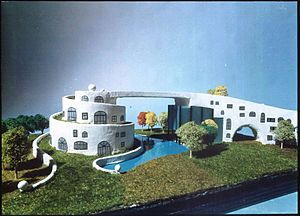
- In New Zealand, a company that makes terracotta tiles has adopted his design ideas, calling it "Organic Tiling." The designer, Chris Southern, worked with Hundertwasser on the Kawakawa toilets.
- In 2022, an art gallery opened in Whangārei, New Zealand, designed in his style and featuring his artwork.
- In 1987, British designer Richard Evans created a tribute to Hundertwasser for the cover of the band Public Image Limited's album Happy?.
Awards and Recognition
- 1959: Sanbra prize at the São Paulo Biennale
- 1961: Mainichi Prize in Tokyo
- 1980: Grand Austrian State Prize for Visual Arts
- 1981: Austrian Nature Protection Award
- 1982: Award-winning Author of the year
- 1985: Officier de l'Ordre des Arts et des Lettres (a French award for arts and literature)
- 1988: Gold Medal of the City of Vienna
- 1988: Gold Medal of Styria
- 1997: Grand Decoration of Honour for Services to the Republic of Austria
Documentary Films About Hundertwasser
- Ferry Radax: Hundertwasser – Leben in Spiralen (Hundertwasser – life in spirals, 1966).
- Ferry Radax: Hundertwasser in Neuseeland (Hundertwasser in New Zealand, 1998).
- Peter Schamoni: Hundertwasser Regentag (Hundertwasser's Rainy Day, 1972). This film is about the artist rebuilding an old wooden ship.
Images for kids
See also
 In Spanish: Friedensreich Hundertwasser para niños
In Spanish: Friedensreich Hundertwasser para niños
- Roof garden
- Green roof
- Urban agriculture
- Skyrise greenery
- Cool roof
- Green wall


